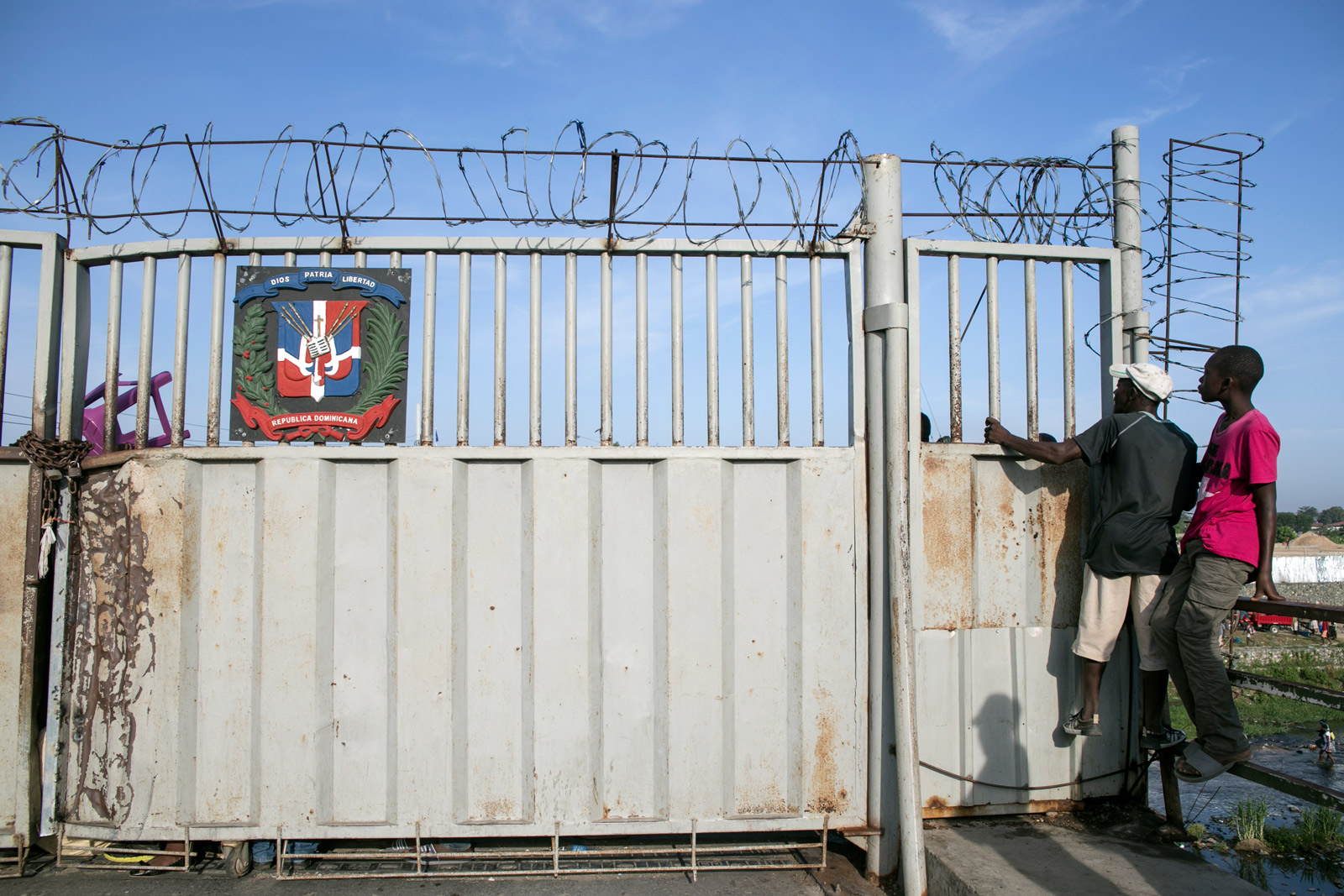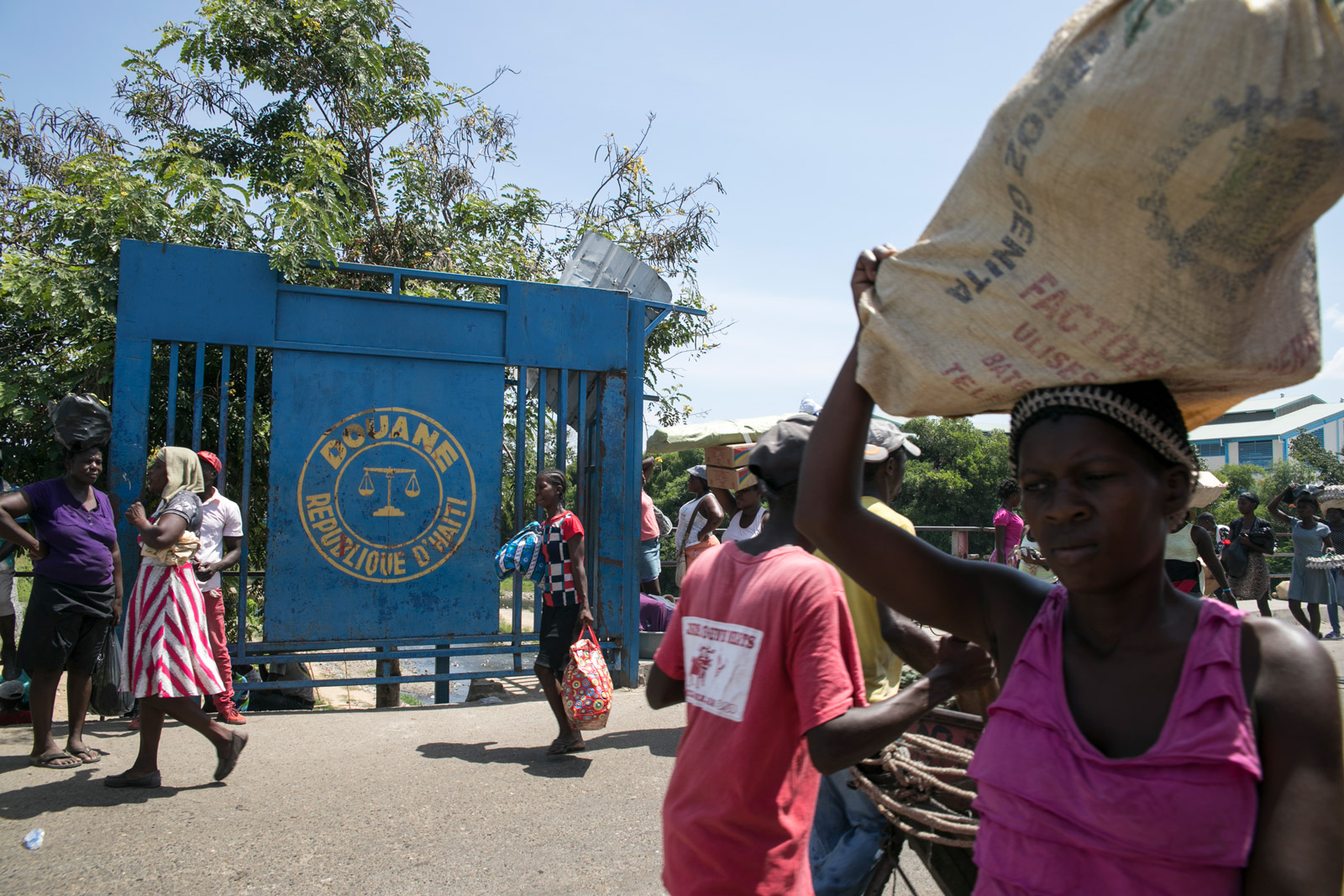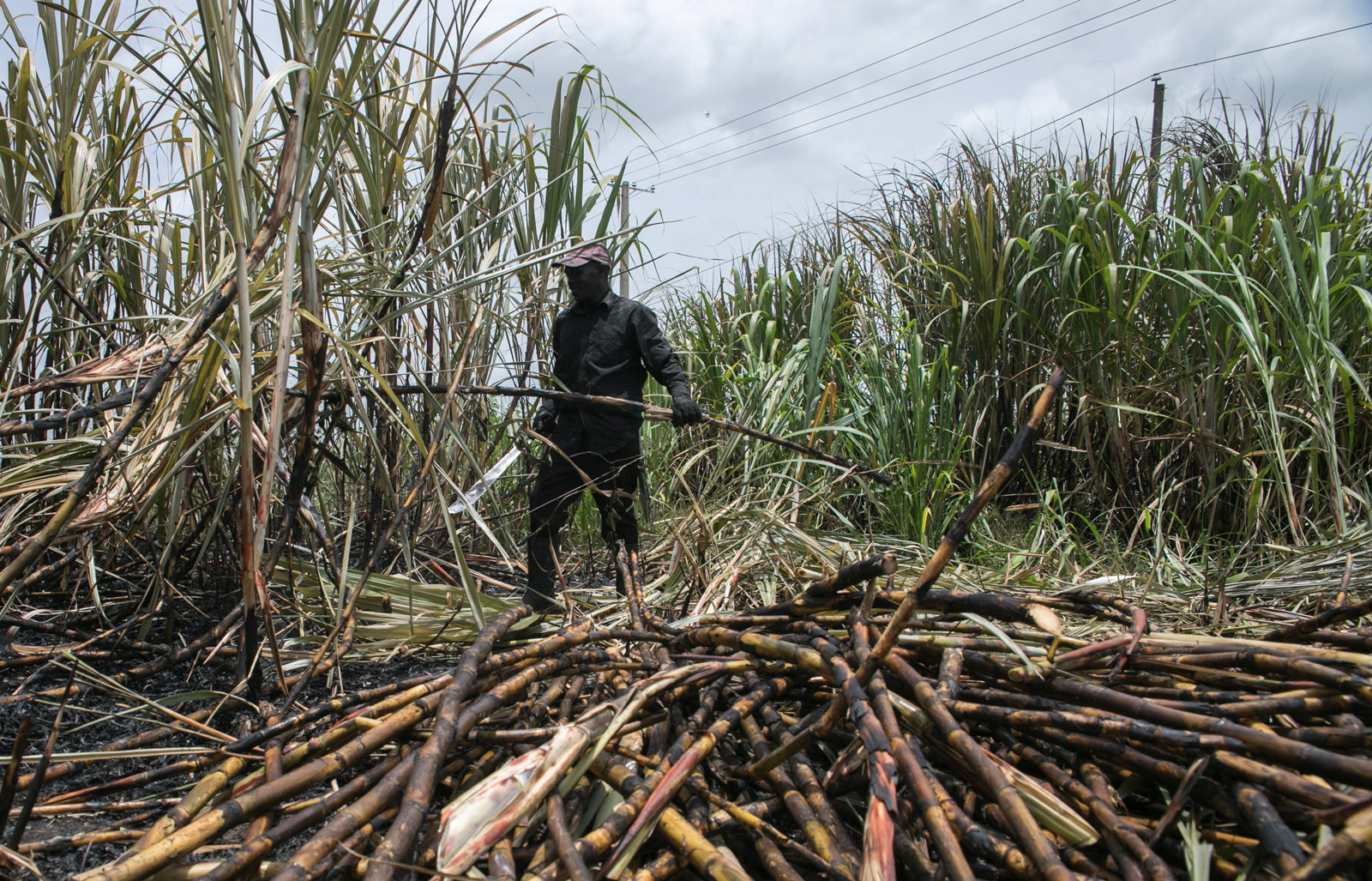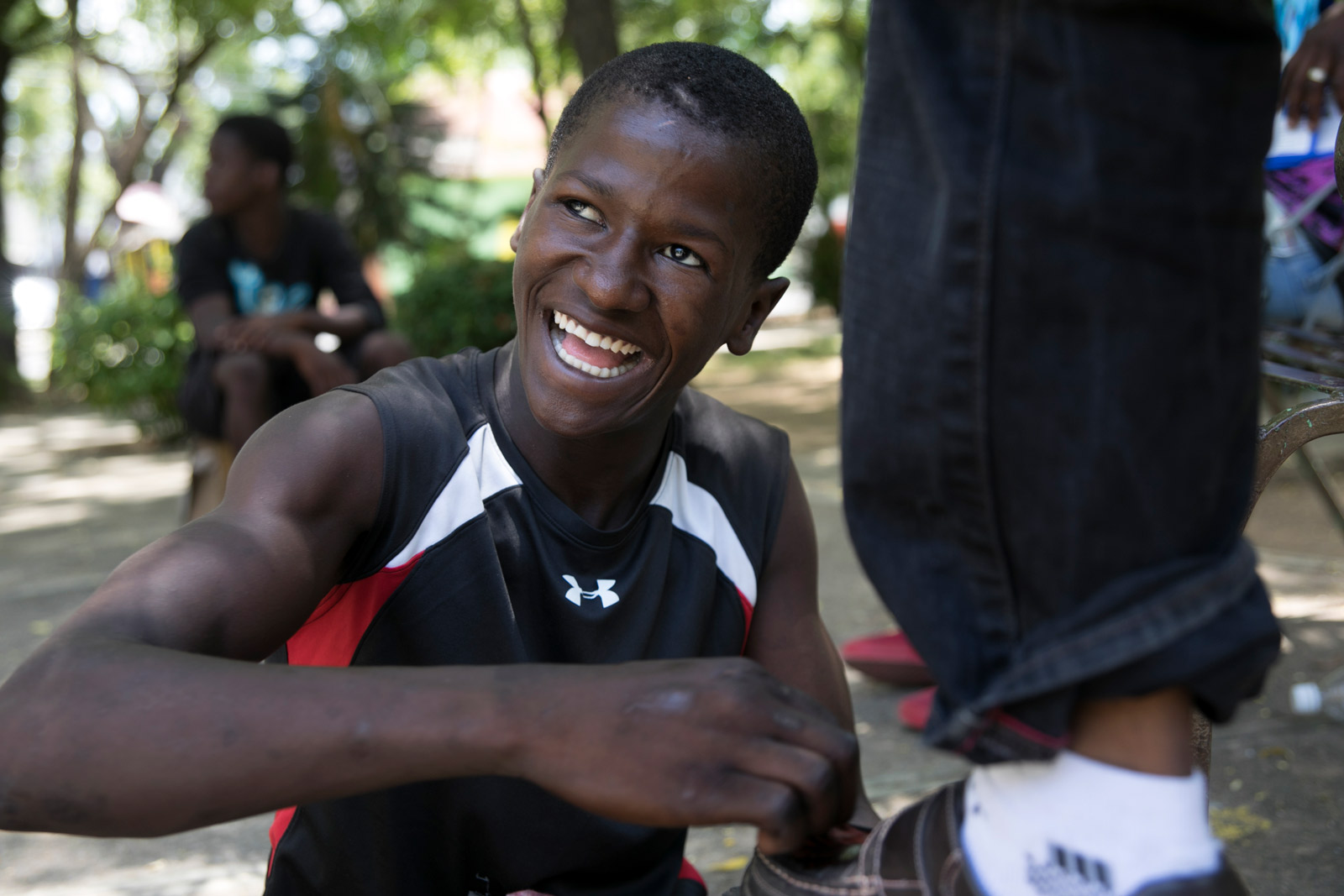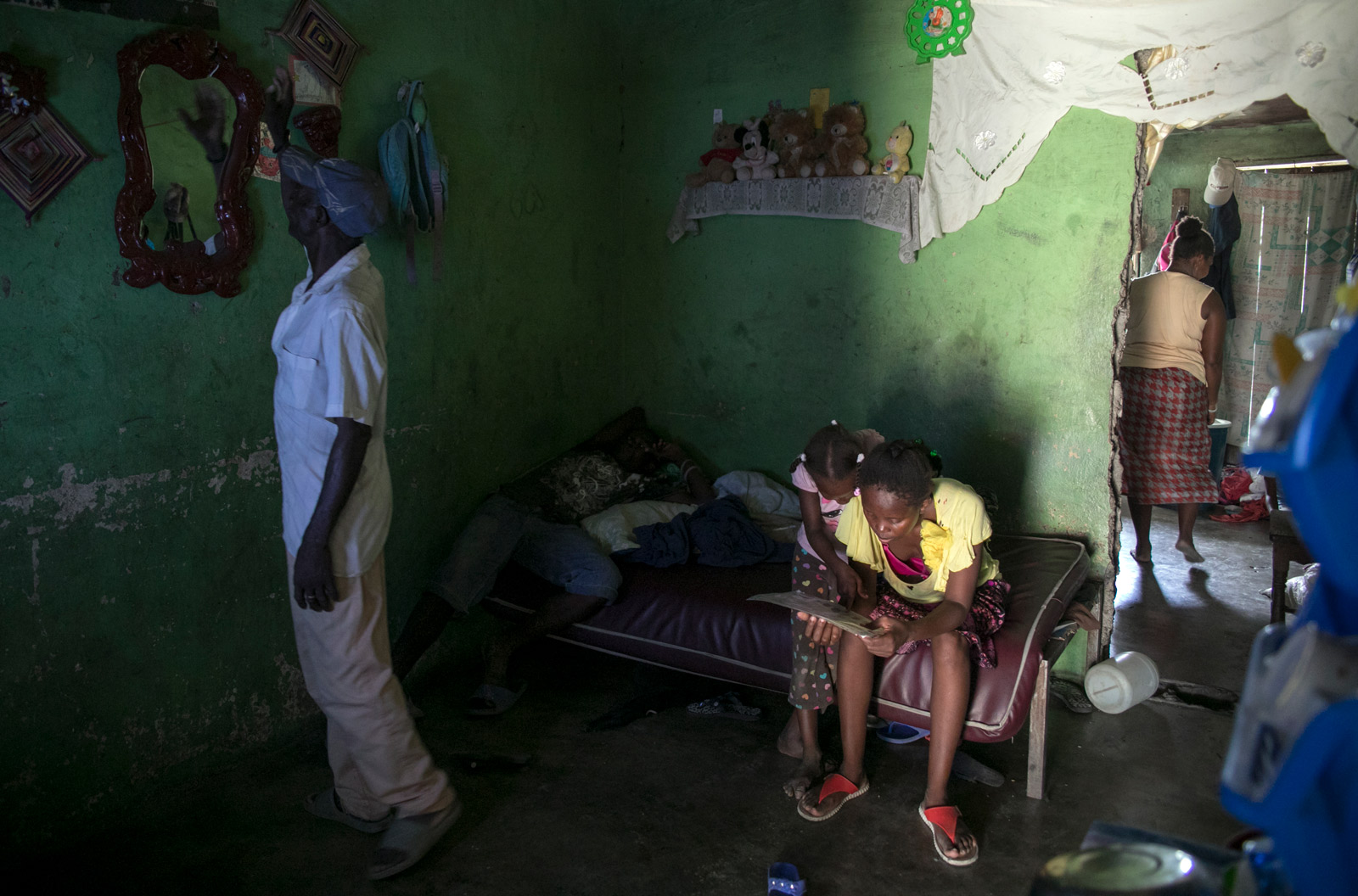Women and men press against the barbed-wire gate, waiting for the guards to let them in. Twice a week, the border crossing opens so that Haitians can get access without a visa to a market located on Dominican land in the northern city of Dajabón, just a short walk from the crossing point.
Behind the crowd at the gate, a loud procession is making its way along the Massacre River (so named for the 1728 killing of a group of French buccaneers by Spanish settlers) that separates Haiti and the Dominican Republic before crossing a short bridge that connects the two countries. Many of those making this trek have come from Ouanaminthe, the nearby Haitian town, while others’ journeys started much deeper inside Haiti. Some are carrying heavy loads and most are commuting by foot, though there are some on motorcycles and a few, privileged ones ride cars or small trucks.
It’s 8 AM on a hot and sultry Friday. The guards, holding their weapons tightly, finally open the gate, letting the travelers—mostly buyers—onto Dominican soil. Under the watchful eyes of border agents, the sellers rush to the space allocated to them, carrying food, clothes, and other goods. The two-story cement building that houses the market cannot hold all the merchants, so many settle outside, as buyers find their way through the crowded arena, undeterred by the suffocating heat. A woman carrying a large bucket containing shampoo, deodorant, and socks walks around the market yelling out prices. Two other women lay a sheet on the floor, selling shoes that they purchased in Cap Haitien. The vendors generally aren’t picky about currencies; they will take anything—Haitian gourdes, Dominican pesos, or US dollars.
The two towns, Dajabón and Ouanaminthe, only a bridge away, nevertheless exist worlds apart, with vast differences in language, culture, religion—and most of all, development. Dirt roads and poverty stand on the Haitian side to the west, while supermarkets, shops, and visible prosperity occupy the Dominican side on the east.
Haiti and the Dominican Republic share the island of Hispaniola, the largest in the Caribbean after Cuba, but the peoples on either side of the island rarely mix thanks to decades of political tensions and mutual fears fed by a history of wars, massacres, and other atrocities. Some are hopeful that the Dajabón market is a testament to these neighbors’ capacity to get along. But as politicians have manipulated racialized anxieties and fears that defy economic logic and business interests, the strain between the two countries has only intensified.
For decades, Haitians living in a country struck by natural disasters and shaken by political instability have looked for work in the Dominican Republic, where a healthier economy and more robust economic growth—and, in turn, a need for low-waged Haitian labor—has created openings. Controlling the movement of people across the border has historically been a challenge for the authorities, as it is relatively easy for Haitians to bribe Dominican border guards to get to the other side. Inside the Dominican Republic, though, Haitians have long suffered abuses. In recent years, thousands have been pressured to leave voluntarily or have been forcibly deported, including documented cases of people of Haitian descent who were actually born in the Dominican Republic.
Yet the economic imperative for Haitians to attempt the border crossing has never slackened; those who do so are leaving the poorest country in the Western Hemisphere. When Haiti’s government sharply increased fuel prices in 2018, in accordance with a deal with the International Monetary Fund, political tensions escalated. A series of protests followed by violence, pillaging, and arson exposed how fragile the country’s political stability is—and how much the country’s elites are letting down their own people. After the 2010 earthquake that killed at least 220,000 Haitians, billions of dollars in aid poured into the country, but rampant corruption, corrosive poverty, misguided governance, and extreme weather events have prevented any significant improvement, and Haitians continue to struggle for better lives.
In contrast, the Dominican economy has experienced decades of rapid growth—though few of the resulting benefits have trickled down and created well-paid jobs, Pavel Isa Contreras, a Dominican economist at the Santo Domingo Institute of Technology, told me. As a result, many Dominicans emigrate for better-paid employment abroad, often in the United States; in fact, these emigrés outnumber the Haitian immigrants who come to work in their native land. In Contreras’s view, the availability of cheap Haitian labor—for jobs that Dominicans wouldn’t want anyway—has provided the backbone for the DR’s strong economic growth. But that doesn’t mean Haitians are welcomed there.
Advertisement
The historical animosity between Haitians and Dominicans is rooted not only in language, but in attitudes toward race. Santo Domingo, founded in 1496 by Spaniards, was the first European colony in the Americas. The French settled in the western part of the island, where they made a fortune by using slaves to grow sugar cane. Then, in 1791, a slave rebellion drove out the French, making Haiti the world’s first independent black republic in 1804. In 1822, Haiti occupied its Spanish-speaking neighbor, an episode in that country’s history that has left the image of Haitians as machete-wielding killers in the collective imagination of many Dominicans. And although Haitians later helped Dominicans to expel the Spanish colonizers, in 1863–1865, the Dominican Republic still chooses to celebrate its independence from Haiti in 1844.
While Haitians embrace blackness, Dominicans distance themselves from it, says Matías Bosch, an activist, a professor in Santo Domingo, and the grandson of President Juan Bosch, the first democratically-elected president in Dominican history after the fall of the brutal dictator Rafael Trujillo. “One of the characteristics of Dominican racism is that it is not assumed to be racism,” Bosch told me, explaining that anti-Haitian bias is often couched in covert terms, like expressing concerns about immigration, public spending, or public health. “When you peel back the first layer, the second layer, what you have left, in the end, is pure racism.”
In 1937, that history of enmity and bigotry resulted in the massacre of an estimated 20,000 Haitians along the border by Dominican soldiers armed with machetes. What became known as the Parsley Massacre—so called, according to legend, because soldiers challenged people to pronounce the word “parsley” in Spanish to identify whether they were Dominican or Haitian, killing them if they could not—was ordered by Trujillo. The Dominican strongman pursued harsh anti-Haitian policies despite the fact that one of his grandparents was from Haiti.
Nancy Betances’s blue-eyed, white-skinned grandfather was a soldier under Trujillo, brought from Santiago to the border zone to kill Haitians. When she was little, she would sit on his lap and listen to stories of the atrocities—though he used to tell her that he had also helped many Haitians escape. He had no choice, he said, but to carry out orders because the Trujillo regime had threatened reprisals against his own family if he disobeyed. Betances is motivated by strong religious convictions. “If they say that we are God’s image and likeness,” she told me, “then the Haitians are that, too.” She does humanitarian work with Haitians and Dominicans with Haitian ancestry as a way to redeem her grandfather’s legacy. At the Dajabón border, she tries to prevent the trafficking of children, a problem that has been documented by UNICEF. She spotted one young girl who was accompanied by a man whom she suspected—correctly—was not a family member. Border guards arrested him and placed the girl in the care of the authorities.
The economic relationship between the two countries was established in the 1930s during the decades of Trujillo dictatorship. The sugar companies on which the Dominican economy depended demanded cheaper labor and started hiring Haitian workers, who came to the DR during cane-cutting season and then returned to Haiti. But over the years, many of them stayed, settled, and raised families in the impoverished bateys, small settlements of rudimentary accommodation built by their Dominican employers. These creole-speaking migrant workers toiled for very low wages, making barely enough to feed their families. In cane-cutting season, they would work for long hours every day of the month, and their plantation living arrangements kept them secluded from the outside world.
I visited one batey, about two hours east of Santo Domingo. We drove off the main highway, passing gas stations, supermarkets, and shopping malls, and finally made a turn down a dirt road, crossing a sugar plantation. I saw a couple of workers cutting cane under the blazing sun, and nearby there was a small settlement without electricity and running water. In front of the modest shacks, children played, sharing the field with roosters and pigs. Even the Dominican driver who took me there—a first time for him, as well—sat in a state of mild shock, trying to absorb what he was seeing.
Some bateys have become more developed, gaining electricity and other amenities. Over time, the Spanish-speaking children of Haitian immigrants started leaving the bateys to attend local schools. As the sugar industry declined and the DR’s economy diversified, Haitians started working in construction or in service jobs at the tourist resorts along the coastline. The rise of more educated second-generation immigrants led to greater demands for equality and better lives—demands that were met with tougher immigration laws and the mounting anti-Haitian sentiment that still plagues the country.
Advertisement
Today, an estimated half-million Haitians live in the Dominican Republic, a country of about 10.6 million people. Juliana Deguis Pierre belongs to this second generation. Though she was born in the Dominican Republic to Haitian parents who settled in the 1970s, the Dominican authorities refused in 2008 to issue her with a Dominican identity card when she applied for one, and confiscated her Dominican birth certificate. She became the plaintiff in a landmark legal case that became known as “La Sentencia.” The country’s highest court, the Constitutional Court, ruled retroactively in 2013 that immigrants with irregular migration status should not have been able to document their children, even though they were born in the country. Tens of thousands of Dominicans of Haitian descent, mostly poor people, were stripped of citizen rights, making many effectively stateless. The ruling applies to anyone born between 1929 and 2007.
According to the UNHCR, 133,770 people became stateless after the 2013 court decision. The International Organization for Migration has reported that 160,452 people moved back to Haiti voluntarily between mid-June 2015 and December 2016, while 54,510 were officially deported, some of whom are still living in makeshift camps on the Haitian side of the border.
An uproar in the international community followed, including protests from Caribbean island governments and the international human rights community. In 2014, the Dominican authorities conceded by legislating that those whose papers were suspended should be restored their documents, and those who had never been registered but had that right under the Constitution when they were born should be allowed to register as foreigners and could opt to naturalize as citizens after two years. Organizations helping Haitians and denationalized Dominicans to regularize their situation, such as the Asociación Scalabriniana al Servicio de Movilidad Humana, a local human rights organization that focuses on immigrant rights and the rights of descendants born in country, have reported inconsistent bureaucratic demands, delays, and obstacles; to date, only a few thousand applicants have received confirmation of their citizenship status and residency rights.
As of mid-2018, the status of some 250,000 persons issued with temporary regularization permits remains uncertain. None of the unregistered Dominicans of Haitian ancestry have been naturalized so far, and only a third of those Dominicans of foreign ancestry who had papers have regained them. There has also been a growing number of deportations of Haitians with irregular migration status since mid-2015, following a harsh deadline imposed by the authorities to submit paperwork. Today, there is still a risk for Dominicans of Haitian ancestry of being deported on erroneous grounds if they lack their Dominican papers.
Franklin Dinol, a twenty-eight-year-old founder of Reconocido, an organization that fights for the rights of Dominicans of Haitian descent, first encountered problems when he tried to get a birth certificate in order to apply for university in 2007. It took him seven years to get the proper identification papers.
“I lost study opportunities. I lost a university scholarship. When I lost that university scholarship, I lost those years too,” he said. “Today, I could have been a professional already, a graduate, and I’m not. And I have to invest four more years of my life in that.”
Bridget Wooding, who heads the Observatory of Caribbean Migrants, a think tank in Santo Domingo that focuses on issues of nationality and migration in the DR, told me that the court ruling put the Dominican authorities in an impossible situation. “By their own figures, there were 200,000 irregular Haitians who were not reached by the regularization program,” she said. “But they did not have the logistics to deport en masse, such that, in the first instance, emphasis was placed on creating an environment conducive to encouraging people to self-repatriate.”
The effects of that policy are visible on the walls of Dominican towns daubed with the slogan “Fuera Haitianos” (Haitians out). But there are many Dominicans, too, like Mario Serrano, who have been moved to help Haitians. I met Serrano—a Jesuit priest who was among those who camped outside the Interior Ministry to protest the citizenship ruling in 2013—at a shelter in Dajabón set up by Hogar de Cristo (Home of Christ), a charitable organization that takes in homeless Haitian children, many of whom beg on the streets. Most of these children made their way to the Dominican Republic on their own, in pursuit of a brighter future or as a matter of survival. Some live rough in the park in the town center; to them, the Home of Christ provides some dignity and safety.
“They are the poorest among the poor,” Serrano said. “They also teach me how to live and give meaning to my life.”
I watched as Serrano, who prefers to be called Mario, played with the kids as they waited for dinner, while others watched Karate Kid on TV in Spanish. He exchanged jokes with them in Haitian Creole, a language he learned years ago. The boys, most of whom are between eight and fifteen, usually come in at 5 PM when the shelter opens its doors. (On this night, they were all boys, but sometimes there are girls, too.) There, they can shower, eat, and sleep, only to go back on the streets the next morning.
“In the imagination, Haitians are a load on the shoulders of Dominicans,” Serrano told me. “That’s a way of deforming the reality because our economy has been on the shoulders of Haitians. It has been a mutual gain.”
One of the boys who sleeps at the shelter, a fifteen-year-old named Jeffrey Valcou, likes to speak Spanish and told me that he wants his last name to be Rodriguez because he feels Dominican. He has lived on the central square in Dajabón since he was eight. He shines shoes for ten or twenty Dominican pesos (twenty to forty cents in US dollars). His mother, who left when he was seven, lives not too far away, in Santiago. His father, who at first insisted on keeping his son, lives back in Ouanaminthe; but Jeffrey later made the journey across the border with another adult.
“I don’t know anything about Haiti. I like living here,” he said, despite the anti-Haitian xenophobia he often experiences. He himself has been deported some twenty times, he said, but he always found his way back.
Earlier this year, on a different trip, I visited a center that cares for deported minors on the Haitian side of the border. The stories they told, of neglect and abuse on both sides of the border, were similar. These children usually cross with a cousin, a sibling or a friend, or even a group. They are frequently attacked and robbed. One, a boy who asked to go by his initials only, W.K., tried working on a construction site. “But after twenty-two days I stopped, because I was too small and it was too hard,” he told me. Many eventually end up getting deported, sometimes in the middle of night. Some shared accounts of brutality and beatings during their detention.
This is all happening at a time when certain Dominican politicians have successfully manipulated anti-Haitian feeling for political gain, tapping into the racist discourse that has plagued much of the public conversation in the DR for years. The media over-report crimes perpetrated by Haitians, portraying them as a threat, always highlighting their ethnicity. Radio shows discuss the Haitian “invasion” that must be stopped at all costs.
There is a widespread belief that Haiti is a failed state, and that the world is conspiring against the Dominican Republic to force it to deal with its neighbor’s problems. There is a fear, too, of their country being somehow contaminated by Haiti’s ills. The international community has decided that the Dominican Republic should play the role of a buffer state—like “the role that Jordan has played with the Palestinian crisis,” said Pelegrín Castillo, a former minister, a founder of the National Progressive Force Party, and a strong backer of the 2013 Constitutional Court ruling. Today, he supports still stricter immigration measures, emboldened by the current US administration.
“Before President Trump proposed the wall with Mexico, we in the Dominican Republic have been raising the need for a wall,” he told me, in his office in Santo Domingo. “We see in the Trump administration and in the policies that he promotes an opportunity to rethink all these issues, because with the previous administration it was not possible.”
Castillo’s perspective is a world away from Beneco Enecia’s. Enecia, today the director of a community development group called CEDESO, grew up on a batey in a family of seven children. His parents were the children of Haitian immigrants; his father, who cut sugar cane for a living, died when Enecia was young. Enecia discovered the world outside the bateys when he left for college, and he grew up feeling Dominican, listening to merengue music and speaking Spanish. He even became the mayor of his local community. He is proud of his mixed heritage. “Sometimes I don’t even know in which language am I thinking or dreaming,” he said. He sees anti-Haitianism as a tool wielded by politicians like Castillo.
“I think there is an elite, a sector of society, which seeks to establish a fear in the assumption that Haiti represents a threat and… [therefore that] Haitians represent a threat to the Dominican Republic,” Enecia told me. “But, in the end… what they seek to establish is the racial difference between Dominicans and Haitians.”
It is hard for an outsider to understand these racial divides that are all but invisible to the eye. But looking back at the history of both nations, back to when each country took its turn at oppressing the other, healing wounds that are still fresh may seem impossible. But the offspring of the original sugar-cane cutters are eager for change. Their parents worked under inhuman conditions to give them a chance for a better life. All they can do now is fight injustice and dream. That day in Dajabón, I crossed to Haiti on a motorcycle that I shared with a Haitian and a Dominican. During the ride, they had a lively conversation in Spanish, and for those brief moments, the hope for peaceful coexistence seemed within reach.
Tatiana Fernández and Jean Pharès Jérôme contributed reporting. This story was produced with support from Round Earth Media.


